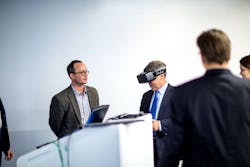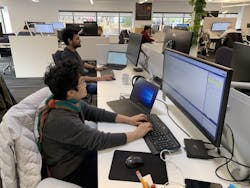Meet the ‘AEC outsiders’ who are helping to push the industry into the new decade
As part of BD+C’s 2019 Giants 300 Technology and Innovation Study, 130 of the nation’s largest AEC firms were polled on a variety of topics, including whether or not the firm had a non-AEC hire in the past 24 months. Nearly two-thirds (63.8%) reported that they had hired an “AEC outsider” in this time period.
Software programmer (35.4%), data analyst (29.2%), game designer/VR specialist and Lean/Six Sigma expert (both 16.2%), and AI/machine learning (ML) specialist (9.2%) were the most popular hires. (Download the final report at BDCnetwork.com/2019TechSurvey.)
Each of these AEC outsider jobs are unique, serving very different purposes, but they are all meant to help their respective firms with the same main goal: drive innovation efforts.
Sure, these firms could train a few current employees in the latest in game design or machine learning, but AEC professionals have enough on their plates without becoming specialists in a new skill outside of their wheelhouse.
See Also: Buildings as "open source platforms"
Software Programming
With the amount of data firms are currently collecting, it has become impossible to manually process it. That’s where the software programmer comes in.
“We gather feedback from the occupants of our buildings, both before and after they move. This is a huge amount of data and it needs to be processed and analyzed automatically,” says Dane Stokes, Design Technology Specialist with ZGF Architects. “The creation and management of these systems is the brunt of this position.”
ZGF currently has one software programmer whose specific job it is to help ease the collection and management of data. The ability to collect, process, and understand this data more quickly and accurately allows ZGF to better understand user satisfaction of its projects at a meaningful scale.
DPR Construction, on the other hand, currently employs approximately 20 people as part of its software and data team. The first hire for the role occurred in 2008 when the firm realized off-the-shelf solutions didn’t fully solve its business problems and created silos of information. “There was a need to create integrations between point solutions and systems of record so that we could build efficiencies into our construction lifecycle,” said Hrishi Maha, National Data and Analytics Leader, DPR.
DPR’s software and data team developed an application called ourPlan (later acquired by Autodesk and rebranded as BIM 360 Plan). OurPlan was a Lean construction planning Web application that supported the Last Planner System for optimizing short-interval planning. The app gave everyone involved with a project access to a detailed plan, keeping the entire team informed of the current schedule at any given time. This helped to reduce the need for constant status meetings and shaved weeks of time from traditional construction schedules.
DPR considers ourPlan its biggest innovation success to date. “Software developers have allowed DPR to leverage modern technologies and bring efficiencies to how we build our projects better, faster, and smarter,” Maha said. “It makes life easier for project team members and puts them in a position to succeed by leveraging technical tools.”
Leland Curtis, Smithgroup Computation Leader. Photo: Smithgroup.
Game Designers and VR Specialists
Seven years ago, HDR created a new position, Visualization + Interactive Design (V+ID) Manager, that applies to all HDR practice groups worldwide. “A major reason for the creation of a role leveraging gaming technologies was to incorporate more sophisticated visualization options,” said Scott Foral, Vice President with HDR.
In the seven years since the position was created, HDR’s V+ID Manager has worked on myriad projects, including serving as the primary software architect for a prototype BIM application on the $3.98 billion Governor Mario M. Cuomo Bridge project. The V+ID Manager used gaming technology to create superior visual quality and performance connected to a structured query language database for design and construction documentation, as well as per-element attribution.
The V+ID Manager and VR teams also developed a companywide application called VisSuite. The custom-designed application was developed completely in-house and gives employees the ability to create portfolios of various content such as model viewing, VR and AR with models, 360 panoramas with annotation and navigation points, and point cloud optimization and viewing. All of the created content is shareable to internal colleagues and external clients for mobile device viewing. The entire system was created with a game engine.
Game designers bring technical capabilities others don’t have, which is important, especially as the industry moves toward a more BIM-centric future. “As all things move to model-based designs, these specialists bring a very unique eye and skillset to show what can further be done with those models,” Foral said. “This capability extends beyond all current known technologies with gaming engines and far into the future.”
AI and machine learning specialist
Five years ago, SmithGroup created two new focus areas within its Technology in Practice group: Data Solutions and Computation. The two groups work together to improve the acquisition, analysis, and study of data for client projects. “This may range from surveying 1,000 employees of a client, to using indoor environmental data to predict occupancy, to utilizing machine learning algorithms to create better programming scenarios,” said Derek White, CIO, SmithGroup.
A little over two years ago, the group’s focus on AI and ML increased. The two groups consist of a total of six people—with backgrounds in architecture, engineering, sociology, research, and data science—four of which are actively pursuing AI and ML efforts.
One of these efforts is SensorLab, a project being led by SmithGroup’s data scientist, software developers, and a mechanical engineer. The team collected hundreds of millions of data points focusing on indoor human comfort and combined it with additional data sets, including meeting invites and facial detection to provide an accurate understanding of office occupancy, utilization, and human impact on environmental conditions. This data was then fed into a predictive model to anticipate occupancy of rooms and the occupancy impacts on air quality.
“Our SensorLab work is probably the most complete example of combining big data, machine learning, and prediction to provide greater understanding of human impact on interior space,” says White. Currently, the predictive model is being used to proactively control building mechanical systems in advance of negative environmental factors.
ML specialists are also working to create systems that accelerate the analysis of images and video collected by stationary cameras and drones to count people and other objects such as cars, as well as being used to deliver real-time performance analysis within a collaborative design environment via Neural Network regressors trained from pre-simulated data. “There are multiple avenues that are more open to us with this expertise in-house,” says White.
Helen Ouyand, and Kalyan Pemmasani, members of DPR Construction's software and data team. Courtesy DPR Construction.
The future is bright for AEC outsiders
All AEC outsider positions are set to expand as technology continues to advance and imbue the industry.
Data collection isn’t slowing anytime soon, which means more software programmers are going to be needed to accurately collect, manage, and process data. And as both firms and clients see the value of advanced visualization services, game designers and VR specialists will need to keep moving past the old boundaries and drawing new ones.
While AI and ML specialists represent a smaller segment of outsider hires in the industry, the future of these positions may be the most important of all. Not only do AI and ML expand design opportunities that were previously unattainable, but these technologies could also help change the entire AEC industry for the better.
“The utilitarian function of AI could provide the catalyst our industry needs to greatly reduce waste that is inherent in our current construction workflow,” says White. “From automatic code review to predictive construction schedule impacts, construction projects stand to benefit from not only a streamlined process but a significantly superior solution in quality and sustainability to our clients.”
The AEC industry is a much more complex entity than its acronym suggests, and once the benefits of a new way of doing something (i.e., “AEC outsiders”) are seen as useful or better than current practices, it quickly becomes necessary and the new normal. Or, as Foral puts it, “Very soon, the bleeding edge becomes a commodity.” AEC outsiders are about to be the industry’s most valuable commodity.


